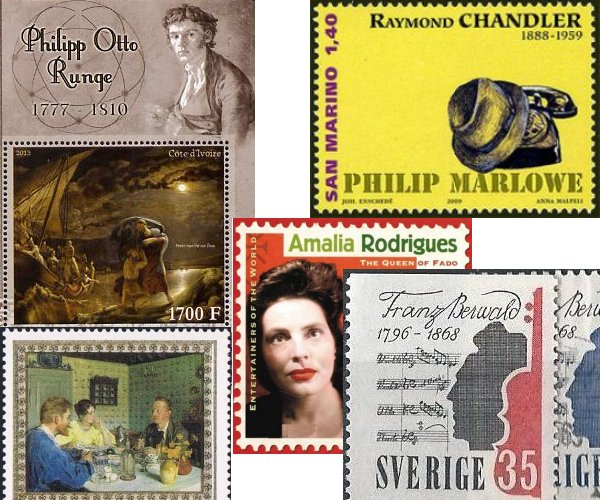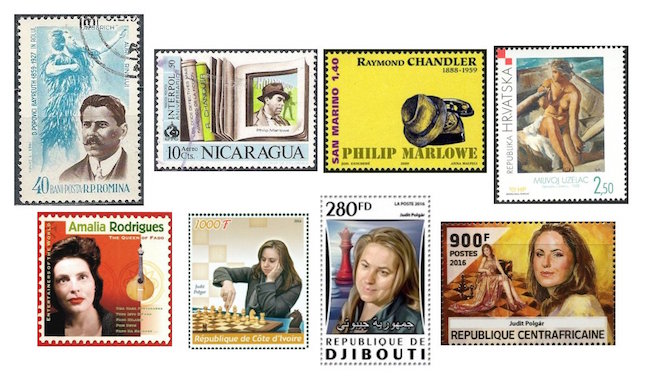The Arts on Stamps of the World — July 23
An Arts Fuse regular feature: the arts on stamps of the world.

By Doug Briscoe
The German painter Philipp Otto Runge (23 July 1777 – 2 December 1810) developed the idea of the first three-dimensional color system, a sphere that was later adapted and expanded into more comprehensive systems (Chevreul, 1839, Munsell, 1900). Runge was born in Pomerania, then under Swedish rule, and studied painting at the Copenhagen Academy and in Dresden. A devout Christian, Runge associated certain colors with aspects of the Holy Trinity and with nature. For example, blue was equated with God the Father and night, yellow with the Holy Spirit. There’s no indication that Runge was a synesthete, however. He was a friend and correspondent of Goethe. A tuberculosis sufferer, he died at age 33. Only one stamp for Runge existed—the German one from 1977—before Côte d’Ivoire came along with a lovely sheet in 2013. The German stamp shows a small detail from a painting called The Great Morning (c1809-10); a companion piece, The Little Morning, had been executed in 1808. The Ivoirian souvenir sheet presents the artist’s self-portrait (1804-05) as a backdrop, with the stamps showing Peter on the Sea (1806-07) and The Hülsenbeckschen Children (1805-06).
Swedish composer Franz Berwald (1796 – 3 April 1868) came from a family of musicians. He received rather little recognition during his lifetime, but is held in high esteem in Scandinavia today, and Grove Online calls him “the leading Scandinavian composer of the early 19th century.” His career was not altogether without its triumphs: his opera Estrella de Soria met with great success at its première in Stockholm in 1862; an 1842 Vienna concert of his overtures earned very favorable plaudits from reviewers; in 1866, he was awarded the Swedish Order of the Polar Star; and in 1867 was appointed professor of composition at the Stockholm Conservatory. Yet he made his living as an orthopedic surgeon. Later he was manager of a glass works. Part of his lack of success as a composer was due to his having been something of an innovator (always problematic for composers). One of his most striking ideas was to combine the scherzo and slow movements of a work within a single unit, as he did in his String Quartet in E-flat (1849) and Symphony “Sérieuse” (1842), the only one of his four symphonies to be performed during his lifetime. Brahms later used this idea in his own String Quintet No. 1 (Op. 88) and Violin sonata No. 2 (Op. 100). I haven’t been able to determine whether Brahms emulated Berwald’s model or invented it independently. This pair of stamps was issued in 1968 for the centenary of Berwald’s death.

Still in Scandinavia, we turn to Norwegian-born Danish painter P. S. Krøyer, the unofficial leader of the group of artists called the Skagen Painters after the small community where they gathered (one of these was Michael Ancher, whose birthday we acknowledged last month) along with writers such as Henrik Pontoppidan, whose birthday is tomorrow. Peder Severin Krøyer (23 July 1851 – 21 November 1909) studied at the Royal Danish Academy of Art, where he won a gold medal. He is still one of the best loved of Scandinavian artists. While visiting Copenhagen many years ago, I was struck by Krøyer’s group portrait of The Hirschsprung Family (1881) and bought a postcard reproduction. (Heinrich Hirschsprung was a long-time patron of the artist.) A more celebrated work, though, is the lovely Summer Evening on the Skagen Southern Beach with Anna Ancher and Marie Krøyer (1893). The first stamp (1988) was not an homage to Krøyer but rather an acknowledgement of the 150th anniversary of the Federation of Danish Industries, for which Krøyer’s painting The Industrialists was selected. The later stamp shows A Breakfast (1893), depicting the artist (at right), his wife, and the writer Otto Benzon.
Romanian bass-baritone Demeter Popovici (1859 – 6 April 1927) studied in Bucharest with the important teacher, administrator, and composer George Stephănescu. Popovici at first undertook mostly rôles from the Italian repertoire, but he sang Tannhäuser in Vienna in 1884 and went on to establish a career as a Wagnerian in Prague (1886-95) and internationally. Not associated with any particular opera house, Popovici performed at La Scala, in Germany, Florence, Russia, Spain, Amsterdam, and the US, though he lived in Vienna. He was for a time director of the Cluj Opera House. His daughter Lilli was a famous Romanian actress.
Among today’s birthday artists I imagine the best-known figure for an American audience is Raymond Chandler (July 23, 1888 – March 26, 1959), the creator of detective Philip Marlowe. Born in Chicago, he grew up in Nebraska and, from age twelve, in London. He returned to the United States in 1912 and took odd lobs until volunteering for the Canadian army and getting a taste of trench warfare in World War I. It was only the impetus of the Great Depression that decided him to resume writing as a means of making a living. He sold his first story in 1933 and published his first novel, the seminal mystery The Big Sleep, in 1939. Its successor, Farewell, My Lovely (1940), drew the attention of Hollywood, and Chandler co-wrote the screenplay for Double Indemnity with Billy Wilder in 1944 and, in 1951, was one of the writers for Hitchcock’s Strangers on a Train. (Ironically, part of the credit for the screenplay for the 1946 version of The Big Sleep went to William Faulkner.) Always subject to depression and alcoholism, Chandler’s decline accelerated after the death of his wife Cissy. Three years ago, the libretto for a comic operetta called The Princess and the Pedlar, written by Chandler in 1917, with music by Julian Pascal, turned up in the Library of Congress.
Croatian artist Milivoj Uzelac (1897-1977) was born in Mostar and grew up there and in Banja Luka, moving to Prague to continue his art studies in 1915. After the war he lived in Zagreb, then, from 1923, in Paris, giving his first solo show there in 1925. He remained in France for the rest of his life, though keeping touch with the art scene in his homeland. The Croatian stamp serves up his painting The Girl in the Boat (1928).

Portuguese fado singer Amália Rodrigues (23 July 1920 – 6 October 1999) was one of the leading voices in the genre in the 20th century. She began singing professionally in 1939 and quickly became a star in Portugal. Called the “Queen of Fado”, she began playing in film in 1946 and even starred in a film called Fado (1947), for which she won a best actress award. (She won another in 1965.) Rodrigues was the first Portuguese singer to appear on American television (1953). She achieved an international career and sold over 30 million records.
Chess is an enormously popular and recurring topic for African souvenir sheets, with Hungarian grandmaster Judit Polgár (born 23 July 1976) showing up on several of them. I show examples from Ivory Coast, Djibouti, and the Central African Republic. Polgár is held by most chess aficionados to be the ablest woman player of any age. Her sister Susan (Zsuzsa) is also among the most highly ranked players in the world.
A graduate of the University of Massachusetts with a B.A. in English, Doug Briscoe worked in Boston classical music radio, at WCRB, WGBH, and WBUR, for about 25 years, beginning in 1977. He has the curious distinction of having succeeded Robert J. Lurtsema twice, first as host of WGBH’s weekday morning classical music program in 1993, then as host of the weekend program when Robert J.’s health failed in 2000. Doug also wrote liner notes for several of the late Gunther Schuller’s GM Recordings releases as well as program notes for the Boston Classical Orchestra. For the past few years he’s been posting a Facebook “blog” of classical music on stamps of the world, which has now been expanded to encompass all the arts for The Arts Fuse.
